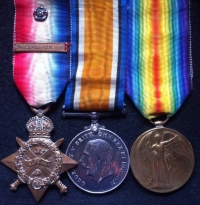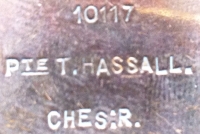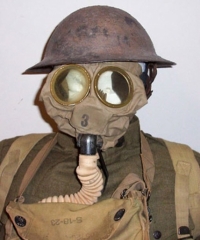





 GAS GAS GAS !!
The Battle of Bellewaarde (24–25 May 1915) Thomas Hassal was admitted to No2 General Hospital, Le Havre on 26th May 1915 with severe bronchitis due to the effects of Gas.
During World War I, the Second Battle of Ypres was fought from 22 April – 25 May 1915 for control of the strategic Flemish town of Ypres in western Belgium. On 24 May the Germans released a gas attack on a 4.3 mile front near Hooge (50.847°N 2.950°E). Although British troops defended and repulsed the initial German attack, there were heavy losses on account of the gas and they were eventually forced to retreat north and south. Failed British counterattacks then forced a British retreat of just over half a mile northwards. At the end of the battle, the Ypres salient was compressed into an area 5 miles long & 3 miles deep with Ypres closer to the line. The city, bombarded by artillery fire, was demolished. This was the final German attack launched as the Battle of Bellewaarde Ridge and ended the Second Battle of Ypres.
GAS GAS GAS !!
The Battle of Bellewaarde (24–25 May 1915) Thomas Hassal was admitted to No2 General Hospital, Le Havre on 26th May 1915 with severe bronchitis due to the effects of Gas.
During World War I, the Second Battle of Ypres was fought from 22 April – 25 May 1915 for control of the strategic Flemish town of Ypres in western Belgium. On 24 May the Germans released a gas attack on a 4.3 mile front near Hooge (50.847°N 2.950°E). Although British troops defended and repulsed the initial German attack, there were heavy losses on account of the gas and they were eventually forced to retreat north and south. Failed British counterattacks then forced a British retreat of just over half a mile northwards. At the end of the battle, the Ypres salient was compressed into an area 5 miles long & 3 miles deep with Ypres closer to the line. The city, bombarded by artillery fire, was demolished. This was the final German attack launched as the Battle of Bellewaarde Ridge and ended the Second Battle of Ypres.
 Although poison gas had been previously used on the Eastern Front, it's use on the Western front totally surprised the Allies and about 7,000 gas casualties were transported to field ambulances units and treated in casualty clearing stations. In May and June, 350 British deaths were recorded from gas poisoning. Both sides further developed gas weapons and counter-measures, which changed the nature of gas warfare with both the French and British using gas at the Battle of Loos in late September. Gas protection was somewhat improved with the issue of improvised respirators made from cotton waste pads impregnated with sodium hypo-sulphite, sodium bicarbonate and glycerin. The respirators made little difference, however, due to lack of training and the use of local contraptions and poorly-made items imported from Britain. The "P helmet" (or "Tube Helmet") soaked in sodium phenate was issued by December 1915, and the PH helmet (effective against phosgene) was issued in early 1916.A CLASSIC OLD CONTEMPTIBLE'S 1914 STAR & BAR TRIO WITH ORIGINAL RIBBONS, CLASP & ROSETTE.£495
Although poison gas had been previously used on the Eastern Front, it's use on the Western front totally surprised the Allies and about 7,000 gas casualties were transported to field ambulances units and treated in casualty clearing stations. In May and June, 350 British deaths were recorded from gas poisoning. Both sides further developed gas weapons and counter-measures, which changed the nature of gas warfare with both the French and British using gas at the Battle of Loos in late September. Gas protection was somewhat improved with the issue of improvised respirators made from cotton waste pads impregnated with sodium hypo-sulphite, sodium bicarbonate and glycerin. The respirators made little difference, however, due to lack of training and the use of local contraptions and poorly-made items imported from Britain. The "P helmet" (or "Tube Helmet") soaked in sodium phenate was issued by December 1915, and the PH helmet (effective against phosgene) was issued in early 1916.A CLASSIC OLD CONTEMPTIBLE'S 1914 STAR & BAR TRIO WITH ORIGINAL RIBBONS, CLASP & ROSETTE.£495